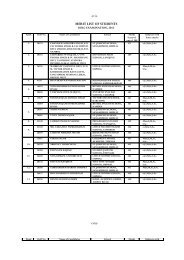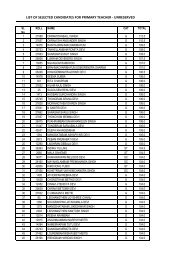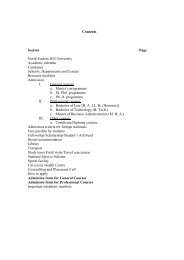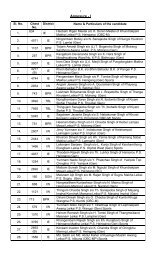AgriManipur - E-paolive.net
AgriManipur - E-paolive.net
AgriManipur - E-paolive.net
- No tags were found...
You also want an ePaper? Increase the reach of your titles
YUMPU automatically turns print PDFs into web optimized ePapers that Google loves.
<strong>AgriManipur</strong> Volume 1, Issue 1Prospects of Clarias magur farming in Manipur- Ch. BasudaCh. Basuda is a scientist working at ICAR Research Complex for NEH Region, ManipurCentre . She is actively involved in developing techniques for scaling up theproduction indigenous fishes and training to farmers. She can be contacted atdevibasu@yahoo.comAquaculture has assumed the status of fastexpanding industry in many countries in theworld. India is basically a carp culture country;the indigenous and exotic carps account forbulk of production. However, interest in theculture of catfish increases rapidly in recentyears due to their high market price and hardynature. Catfishes are easily distinguished bytheir smooth and fewer scale bodies. It lives infresh brackish water and marine habitats. Itcan also be found in marine habitat. Someof the important catfishes found in Manipurare Wallago atu (Sareng), Aorichthyssps (Ngaten), Mystus sps (Ngasep), Ompokbimacuatus (Ngaten), O. pabda, O. pabo,Clarias magur (Ngakra), Heteropneustus fossilis(Ngachik) . They are famous for theirrestorative properties and generally marketedin live state. Hence, these fishes arecommonly known as ‗Live fish‘.These Clariids are a group of fisheswhich, by virtue of the presence of accessoriesrespiratory organ, can thrive well in fallowderelict swampy waters normally consideredas low oxygen environment conditions. Thisability of Clariids to feed and grow in thevirtual absence of dissolved oxygen, coupledwith fast growth, an omnivorous diet andgenerally high resistance to stress, make themof particular interest in aquaculture. Its importancegained momentum since 1985,Clarias magur brooders Hormone injection Stripping of Clarias magur femaleClariid catfishes are grown by small-scaleand large-scale fish farmers in 30 countrieswith a total production of over 3 00 000 t,which was valued at nearly US$400 millionin 2006. Currently, cultured clariid productioncontributes nearly 60% to the totalglobal production (FAO 2009). Twentycountries in Africa, Asia and Europe produceat least 100 t per annum.Among the catfishes Clarias isone of the most important aquaculturespecies in Asia. Clarias magur, commonlyknown as Ngakra in Manipur. It has goodmarket price and fetches a higher price thanthe major carps, owing to its good taste,nutritional and medicinal value. Attemptshave been made for farming of this fish byfew progressive fish farmers in Manipur.However due to inadequate supplies of seedculture of Clarias, production is still verylow. In recent past, C. magur seeds wereavailable in many places in Manipur duringPage 11monsoon and post monsoon months i.e.August-October. The young one of thesefishes were collected in large number frompaddy fields or water logged, low lying areasby employing indigenous fishing devices.The collected fishes were stocked and culturedwith carps in ponds. Collection ofseeds from wild is unreliable, time consumingand uneconomical. To overcome thisconstraint, induced spawning is the onlyoption for supply of quality seeds for Clariasfarming.Recently, ICAR Research Complexfor NEH Region, Manipur Centre anda few progressive farmers produced Clariasseeds for culture by artificial breeding usinghormone injection such as ovaprim, ovatide,wova-FH, etc and stripping.BreedingC. magur exhibits sexual dimorphism anddifferentiating secondary sexual charactersare shape of muscular papilla at vent re-gion. Males have elongated papilla, while femaleswith round button shaped papilla. Thefecundity of this species is very low, though themaximum fecundity recorded was 37720; fisheswith a fecundity range of 15000 to 20000 perkg are common. The breeding period fallsduring June to AugustThe C. magur can be breed by inducinghormones @ 0.8 ml/Kg body weight tofemale. The latency period between injectionand stripping of female is 16 hours at 28°C. The male fishes are held separately in a tankor container before artificial fertilization.Before the female are stripped, male fishwith gravid testis are to be sacrificed, and testesare taken out and macerated in normal saline(0.9% NaCl). The spermatozoa become inactivein this medium and this extract can bemaintained for few hours in refrigerator. After16 hours of latency period female fish isstripped and ova are collected in to dryContd. on page 16
















